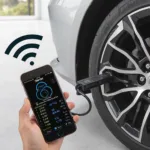An OBD2 EGT monitor is a crucial tool for anyone looking to keep their vehicle running smoothly and efficiently. It provides real-time insights into your engine’s exhaust gas temperature (EGT), helping you identify potential problems before they escalate into costly repairs. This comprehensive guide will explore everything you need to know about OBD2 EGT monitors, from their functionality and benefits to choosing the right one for your needs.
What is an OBD2 EGT Monitor and Why Do You Need One?
Monitoring your vehicle’s EGT is essential for maintaining optimal performance and preventing damage. Excessive EGT can lead to warped valves, melted pistons, and even catastrophic engine failure. An OBD2 EGT monitor taps into your vehicle’s onboard diagnostic system, providing a constant stream of data regarding exhaust gas temperature. This allows you to identify issues such as a clogged catalytic converter, a faulty oxygen sensor, or a rich fuel mixture, all of which can contribute to high EGT. By addressing these issues promptly, you can save yourself a significant amount of money on repairs and extend the life of your engine.
Benefits of Using an OBD2 EGT Monitor
Using an OBD2 EGT monitor offers a multitude of benefits for both car enthusiasts and everyday drivers:
- Early problem detection: Identify potential issues before they become major problems.
- Improved fuel efficiency: Optimize your engine’s performance for better mileage.
- Enhanced engine performance: Maintain optimal operating temperatures for peak power.
- Prevent costly repairs: Avoid expensive damage by addressing issues proactively.
- Increased vehicle lifespan: Protect your engine and extend its overall lifespan.
How Does an OBD2 EGT Monitor Work?
An OBD2 EGT monitor works by communicating with your vehicle’s ECU (Electronic Control Unit). The ECU constantly monitors various engine parameters, including EGT, which is measured by an EGT sensor located in the exhaust system. The OBD2 EGT monitor retrieves this data and displays it in a user-friendly format. Some advanced monitors also allow you to log data and track trends over time, further enhancing your diagnostic capabilities.
Choosing the Right OBD2 EGT Monitor
Selecting the right OBD2 EGT monitor depends on your specific needs and budget. Factors to consider include:
- Display type: Digital or analog.
- Data logging capabilities: Ability to record and review data.
- Additional features: Such as alarms and alerts for high EGT.
- Compatibility: Ensure compatibility with your vehicle’s make and model.
Installing and Using an OBD2 EGT Monitor
Installing an OBD2 EGT monitor is typically a simple process. Most monitors plug directly into your vehicle’s OBD2 port, which is usually located under the dashboard. Once plugged in, the monitor will power on and begin displaying EGT readings. Refer to the specific instructions provided with your monitor for detailed installation guidance.
What is a normal EGT reading?
Normal EGT readings can vary depending on the vehicle and driving conditions. Generally, temperatures between 1200°F and 1600°F are considered normal under heavy load. Consult your vehicle’s manual for specific recommendations.
“Consistent monitoring of EGT is paramount for performance tuning and engine longevity,” says John Miller, a seasoned automotive engineer. “It’s like having a constant pulse on the health of your engine.”
Troubleshooting High EGT
If you notice consistently high EGT readings, it’s crucial to investigate the underlying cause. Potential problems include:
- Clogged catalytic converter: This restriction in the exhaust system can cause excessive backpressure and increased EGT.
- Faulty oxygen sensor: An inaccurate oxygen sensor reading can lead to an incorrect fuel mixture, resulting in high EGT.
- Rich fuel mixture: Too much fuel being injected into the engine can cause incomplete combustion and elevated EGT.
“Ignoring high EGT readings can lead to costly repairs down the line,” adds Sarah Johnson, a certified automotive technician. “A proactive approach to maintenance can save you significant headaches and expense.”
Conclusion
An OBD2 EGT monitor is a valuable tool for maintaining the health and performance of your vehicle’s engine. By providing real-time EGT data, it allows you to identify and address potential issues before they cause significant damage. Choosing the right OBD2 EGT monitor and understanding how to interpret the readings can significantly extend the lifespan of your engine and enhance its performance. Remember, investing in an OBD2 EGT monitor is an investment in the long-term health of your vehicle.
FAQ
- What does EGT stand for? EGT stands for Exhaust Gas Temperature.
- Where is the OBD2 port located? It’s typically located under the dashboard, near the steering wheel.
- How do I install an OBD2 EGT monitor? Most plug directly into the OBD2 port.
- What causes high EGT? Potential causes include a clogged catalytic converter, a faulty oxygen sensor, or a rich fuel mixture.
- What are normal EGT readings? Normal EGT readings vary, but generally fall between 1200°F and 1600°F under heavy load.
- Can an OBD2 EGT monitor improve fuel efficiency? Yes, by helping optimize engine performance.
- Is an OBD2 EGT monitor worth the investment? Yes, it can prevent costly repairs and extend engine life.
For assistance or inquiries, please contact us via WhatsApp: +1(641)206-8880 or Email: [email protected]. We have a 24/7 customer support team ready to help.


